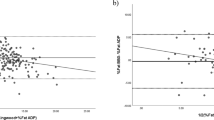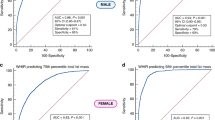Abstract
OBJECTIVE:
To compare length and stature measurements of young children and to examine the relevance of any difference for comparison with body mass index (BMI) references designed for use from birth to adulthood.
SUBJECTS:
A total of 426 2-y-old and 525 3-y-old children included in the Dortmund Nutritional and Anthropometrical Longitudinally Designed (DONALD) Study.
DATA ANALYSIS:
Length and stature were measured to the nearest millimetre using a stadiometre. Agreement between both measurements at age 2 and 3 y, respectively, was determined by mean differences and by comparison with the German BMI reference.
RESULTS:
The average length of 2-y-old girls and boys was 88.3 (3.1) and 89.9 (3.2) cm, mean differences (stature minus length) were −0.47 (0.65) and −0.45 (0.64) cm. The corresponding BMI values were 16.18 (1.3) and 16.46 (1.2) kg/m2, with mean differences of +0.17 (0.24) and +0.16 (0.23). According to stature, 9.4% of the girls and 10.8% of the boys were overweight (>90th percentile), while length classified 7.1 and 9.4% as overweight. Similar mean differences between length and stature were observed at age 3 y: −0.53 (0.62) and −0.47 (0.65) cm in height and +0.17 (0.20) and +0.14 (0.20) kg/m2 in the BMI of girls and boys, respectively. According to stature, 7.6 and 7.3% were overweight as opposed to 5.4 and 4.8% using length. The observed differences increased with higher BMI levels.
CONCLUSION:
Changing measurements from length to stature results in an upward shift of BMI, not reflected in current European BMI references. This small but systematic error may result in misinterpretation of individual BMI levels or trend observations.
This is a preview of subscription content, access via your institution
Access options
Subscribe to this journal
Receive 12 print issues and online access
$259.00 per year
only $21.58 per issue
Buy this article
- Purchase on Springer Link
- Instant access to full article PDF
Prices may be subject to local taxes which are calculated during checkout

Similar content being viewed by others
References
Kuczmarski RJ, Ogden CL, Guo SS, Grummer-Strawn LM, Flegal KM, Mei Z, Wei R, Curtin LR, Roche AF, Johnson CL . 2000 CDC growth charts for the United States: methods and development. Vital Health Stat 11; 2002: 1–190.
van't Hof MA, Haschke F . Euro-Growth references for body mass index and weight for length. Euro-Growth Study Group. J Pediatr Gastroenterol Nutr 2000; 31 (Suppl 1): S48–S59.
Wright CM, Booth IW, Buckler JM, Cameron N, Cole TJ, Healy MJ, Hulse JA, Preece MA, Reilly JJ, Williams AF . Growth reference charts for use in the United Kingdom. Arch Dis Child 2002; 86: 11–14.
Kromeyer-Hauschild K, Wabitsch M, Kunze D, Geller F, Geiss HC, Hesse V, von Hippel A, Jaeger U, Johnsen D, Korte W, Menner K, Müller G, Müller JM, Niemann-Pilatus A, Remer T, Schaefer F, Wittchen H-U, Zabransky S, Zellner K, Ziegler A, Hebebrand J . Perzentile für den Body-mass-Index für das Kindes- und Jugendalter unter Heranziehung verschiedener deutscher Stichproben. Monatsschr Kinderheilkd 2001; 149: 807–818.
Cole TJ, Roede MJ . Centiles of body mass index for Dutch children aged 0–20 years in 1980—a baseline to assess recent trends in obesity. Ann Hum Biol 1999; 26: 303–308.
Nysom K, Molgaard C, Hutchings B, Michaelsen KF . Body mass index of 0 to 45-y-old Danes: reference values and comparison with published European reference values. Int J Obes Relat Metab Disord 2001; 25: 177–184.
Rolland-Cachera MF, Cole TJ, Sempe M, Tichet J, Rossignol C, Charraud A . Body Mass Index variations: centiles from birth to 87 years. Eur J Clin Nutr 1991; 45: 13–21.
He Q, Albertsson-Wikland K, Karlberg J . Population-based body mass index reference values from Goteborg, Sweden: birth to 18 years of age. Acta Paediatr 2000; 89: 582–592.
Cole TJ, Freeman JV, Preece MA . Body mass index reference curves for the UK, 1990. Arch Dis Child 1995; 73: 25–29.
Cole TJ, Bellizzi MC, Flegal KM, Dietz WH . Establishing a standard definition for child overweight and obesity worldwide: international survey. BMJ 2000; 320: 1240–1243.
Guo SS, Wu W, Chumlea WC, Roche AF . Predicting overweight and obesity in adulthood from body mass index values in childhood and adolescence. Am J Clin Nutr 2002; 76: 653–658.
Freedman DS, Dietz WH, Srinivasan SR, Berenson GS . The relation of overweight to cardiovascular risk factors among children and adolescents: the Bogalusa Heart Study. Pediatrics 1999; 103: 1175–1182.
Whitaker RC, Wright JA, Pepe MS, Seidel KD, Dietz WH . Predicting obesity in young adulthood from childhood and parental obesity. N Engl J Med 1997; 337: 869–873.
Kroke A, Manz F, Kersting M, Remer T, Sichert-Hellert W, Alexy U, Lentze MJ . The DONALD Study: history, current status and future perspectives. J Nutr 2004; 43: 45–54.
Remer T, Neubert A, Maser-Gluth C . Anthropometry-based reference values for 24-h urinary creatinine excretion during growth and their use in endocrine and nutritional research. Am J Clin Nutr 2002; 75: 561–569.
van't Hof MA, Haschke F . The Euro-Growth Study: why, who, and how. J Pediatr Gastroenterol Nutr 2000; 31 (Suppl 1): S3–S13.
Altman DG . Practical statistics for medical research. Vols 179–223 Chapman & Hall: New York; 1991. pp 277–321.
Bland JM, Altman DG . Statistical methods for assessing agreement between two methods of clinical measurement. Lancet 1986; 1: 307–310.
Delcourt C, Cubeau J, Balkau B, Papoz L . Limitations of the correlation coefficient in the validation of diet assessment methods. CODIAB-INSERM-ZENECA Pharma Study Group. Epidemiology 1994; 5: 518–524.
Institute S . SAS/Stat User's Guide, Version 6. Cary, NY; 1996.
Haschke F, van't Hof MA . Euro-Growth references for length, weight, and body circumferences. Euro-Growth Study Group. J Pediatr Gastroenterol Nutr 2000; 31 (Suppl 1): S14–S38.
Palmer CE . The relationship of erect body length to supine body length. Hum Biol 1932; 4: 262–271.
Roche AF, Davila GH . Differences between recumbent length and stature within individuals. Growth 1974; 38: 313–320.
Garza C, De Onis M . A new international growth reference for young children. Am J Clin Nutr 1999; 70: 169S–172S.
Cole TJ, Paul AA, Whitehead RG . Weight reference charts for British long-term breastfed infants. Acta Paediatr 2002; 91: 1296–1300.
Flegal KM, Wei R, Ogden C . Weight-for-stature compared with body mass index-for-age growth charts for the United States from the Centers for Disease Control and Prevention. Am J Clin Nutr 2002; 75: 761–766.
Acknowledgements
The participation of all children and their families in the study is gratefully acknowledged. We thank Birgit Holtermann, Ute Kahrweg and Sabine Twenhöven for carrying out the anthropometric measurements. This work was supported by the Ministry of Science and Research of North Rhine-Westphalia, Germany.
Author information
Authors and Affiliations
Corresponding author
Rights and permissions
About this article
Cite this article
Buyken, A., Hahn, S. & Kroke, A. Differences between recumbent length and stature measurement in groups of 2- and 3-y-old children and its relevance for the use of European body mass index references. Int J Obes 29, 24–28 (2005). https://doi.org/10.1038/sj.ijo.0802738
Received:
Revised:
Accepted:
Published:
Issue Date:
DOI: https://doi.org/10.1038/sj.ijo.0802738
Keywords
This article is cited by
-
Socioeconomic differences in childhood length/height trajectories in a middle-income country: a cohort study
BMC Public Health (2014)
-
Übergewicht und Adipositas bei Kindern und Jugendlichen in Deutschland
Bundesgesundheitsblatt - Gesundheitsforschung - Gesundheitsschutz (2010)
-
A comparative evaluation of two different approaches to estimating age at adiposity rebound
International Journal of Obesity (2006)
-
Pediatric obesity highlight: looking into the future
International Journal of Obesity (2005)



